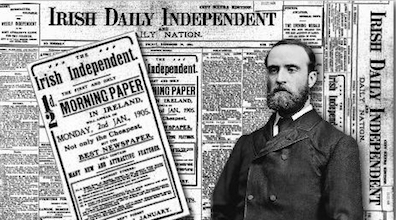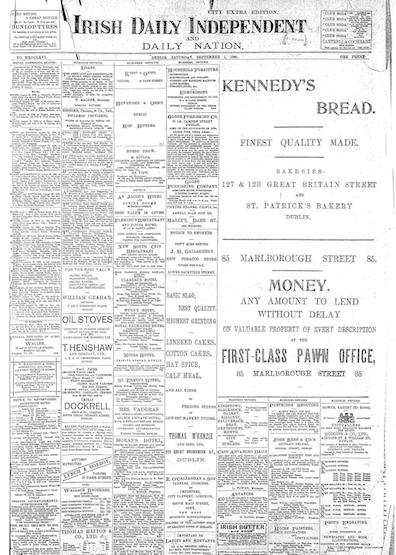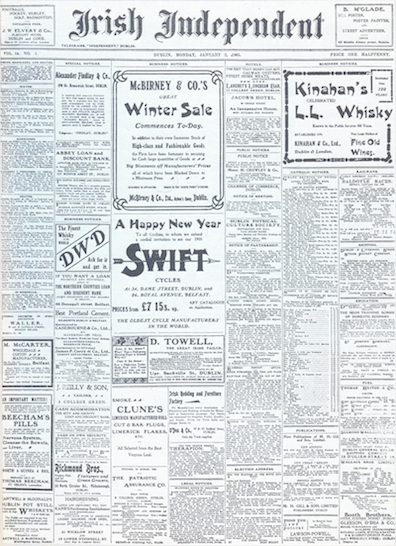Irish Independent
Irish Independent
In Brief
Today the "Irish Independent" is the daily newspaper with the largest
circulation in Ireland, but at the time of the novel's events
it was a somewhat smaller concern called the Irish Daily
Independent, founded in 1890 to support Charles Stewart
Parnell. In Circe the Citizen expresses contempt for
the current state of a paper "founded by Parnell to be the
workingman's friend." He probably would have abominated even
more strongly the new version of the paper, which was launched
in January 1905 and has now lasted for more than a century. It
viciously attacked the labor union movement during the Dublin
lockout of 1913.
Read More
When the divorce trial of Captain William O'Shea and his wife Katharine tore apart Parnell's Irish Parliamentary Party, the Irish Daily Independent was launched by the faction still loyal to the toppled Chief. It opposed the positions of the Freeman's Journal, which had stuck with Parnell through much of the controversy but finally broke away on 21 September 1891, two weeks before his death. By 16 June 1904, however, the warring factions had largely reconciled, and the Independent, as it was commonly called, was owned by William Martin Murphy, a nationalist but staunchly anti-Parnellite businessman from Bantry.According to a page on the website www.irishnewsarchive.com, accessed 13 October 2018, Murphy acquired the paper "around 1904, to prevent the Freeman's Journal from purchasing the title" and thereby to thwart that large paper from monopolizing the nationalist press. He achieved total victory in 1924, when the Independent acquired the Freeman. For decades afterward, the masthead of the Independent bore the legend "Incorporating the Freeman's Journal." Aeolus alludes to these endless newspaper wars when Bloom recalls that before moving to its great rival, "Myles Crawford began on the Independent. Funny the way those newspaper men veer about when they get wind of a new opening. Weathercocks. Hot and cold in the same breath. Wouldn’t know which to believe. One story good till you hear the next. Go for one another baldheaded in the papers and then all blows over. Hail fellow well met the next moment."
The Citizen appears to object mainly to the Independent's cultivation of an English audience. He reads out various names and addresses from accounts of births, deaths, and marriages in the 16 June 1904 issue, all of them English, and concludes, "How’s that for a national press, eh, my brown son! How’s that for Martin Murphy, the Bantry jobber?" Although he is reading from an actual paper, he is doing so selectively. As Gifford shows from careful examination of that day's issue, the Citizen skips over Irish-born babies, marriages, and deaths to concentrate on the offending English names. Although the names sound distinctly upper-class and Protestant, and hence arguably anti-working class, the Citizen does not say anything about the paper's positions on labor issues.
Murphy's successor paper, the Irish Independent, launched on 2 January 1905, adopted a policy of implacable hostility to labor unions when James Larkin, centered in Dublin from 1908 onward, began organizing Ireland's miserably poor and powerless workers. Larkin's union staged successful strikes beginning in 1911, and in 1912 he and James Connolly founded the Irish Labour Party to advance labor issues in the British Parliament. The capitalist backlash against these efforts was led by Martin Murphy, who chaired the Dublin United Tramway Company and owned various other businesses, including the Independent and the Evening Herald.
In July 1913, Murphy organized a meeting of more than 300 Dublin employers to crush the trade union movement. He dismissed several hundred of his employees whom he suspected of belonging to Larkin's Irish Transport and General Workers' Union, and, beginning in late August, businesses across Dublin (not including the Guinness brewery) locked out their workers. The massive lockout was strengthened by strike-breakers and by Dublin Metropolitan Police forces that charged workers at rallies, killing several and injuring hundreds. Throughout the lockout, Murphy's Independent portrayed Larkin as a demonic troublemaker endangering social order. Workers capitulated early in 1914.
Sirens offers one more example of someone carrying about a copy of the Independent, when a gentleman drinking at the bar asks Miss Kennedy about the viceregal cavalcade that has just passed by: "Did she know where the lord lieutenant was going? And heard steelhoofs ringhoof ring. No, she couldn’t say. But it would be in the paper. O, she need not trouble. No trouble. She waved about her outspread Independent, searching, the lord lieutenant, her pinnacles of hair slowmoving, lord lieuten. Too much trouble, first gentleman said. O, not in the least."


Source: www.irishnewsarchive.com.
